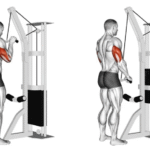Seated Dumbbell Press: Exercise Overview
The seated dumbbell press is a powerful compound exercise designed to target the deltoids, particularly the anterior and medial heads, with secondary engagement of the triceps and upper chest. As a variation of the overhead press, it provides a stable seated position to focus on shoulder strength, while the use of dumbbells promotes unilateral development, helping to correct strength imbalances between sides.
This foundational movement builds upper-body power and supports a balanced physique, making it an excellent addition to shoulder-focused workouts, push routines, upper-body sessions, or full-body training programs. It’s suitable for lifters of all levels aiming to enhance both aesthetic and functional shoulder strength (Schoenfeld, 2010).
How to Perform the Seated Dumbbell Press
- Adjust an incline bench to a 90-degree angle and select an appropriate pair of dumbbells from the rack.
- Sit on the bench with feet flat on the floor, holding the dumbbells with a neutral grip (palms facing inward) and resting them on your knees.
- Carefully kick each dumbbell up to shoulder height, rotating your wrists to a pronated grip (palms facing forward)—this is your starting position.
- Brace your core, inhale, and press the dumbbells overhead by extending your elbows, contracting your deltoids until your arms are nearly straight.
- Pause briefly at the top, then lower the dumbbells back to shoulder level with control, keeping elbows at roughly a 90-degree angle or slightly lower.
- Repeat for the desired number of repetitions.
Tips for Optimal Performance
- Maintain Back Contact: Keep your back pressed firmly against the bench pad to ensure stability and reduce lower-back strain throughout the movement (McGill, 2010).
- Control Head Position: Avoid jutting your head forward to maintain a neutral spine and prevent neck or trap tension (Wirth et al., 2016).
- Keep Tension on Shoulders: Stop just short of fully locking out your elbows at the top to maintain constant deltoid engagement and enhance muscle activation (Schoenfeld, 2016).
- Address Mobility Issues: If you experience neck or trap discomfort, assess for limited thoracic spine extension or shoulder flexion, and incorporate mobility work to improve range of motion (Escamilla et al., 2009).
- Breathe Properly: Exhale as you press the dumbbells overhead and inhale as you lower them to support core stability and muscle oxygenation.
- Choose Appropriate Weight: Select dumbbells that allow controlled form for your target rep range (e.g., 8–12 reps for hypertrophy) to avoid compensatory movements.
Strengthening shoulders with military presses? Explore our Ultimate Guide to Muscle Groups for complete deltoid development.







